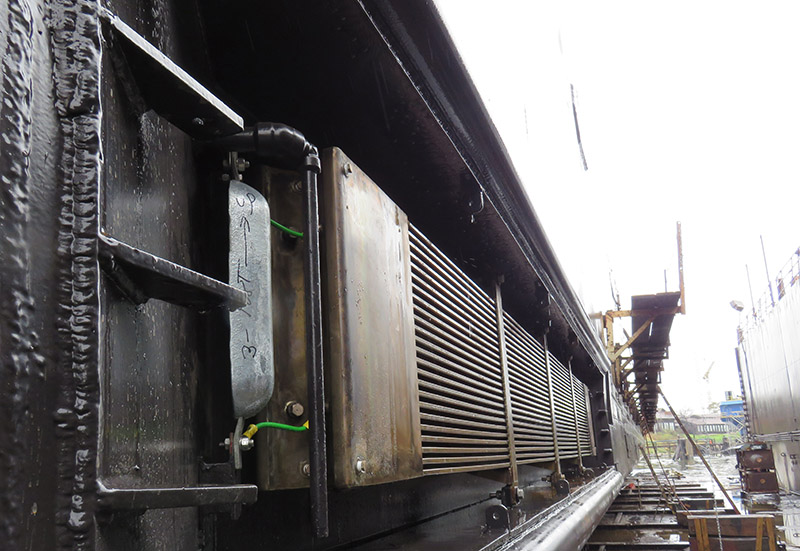Sometimes it just doesn’t make sense to throw something out and replace it with a new item especially when the old one still works. Like that old wool shirt that for 10 years has kept you warm on early spring barge runs across the Gulf of Alaska. Or the filthy old hat you’ve worn in the wheelhouse on trips out to Gulf of Mexico oil platforms. But hauling the same keel cooler from one boat to another?
A New England workboat operator is now on his third boat, and he is using the same set of Walter Machine Co. keel coolers that were on his first two boats, said Don Chatrnuck, Walter Machine’s president.
In this case, if the old engine or engines went into the new boat it shouldn’t be a big problem. However, if it’s a repower with more horsepower and the boat owner doesn’t check with the keel cooler manufacturer to find out if its parameters match up with the new engines for things such as coolant velocity, coolant pump flow rates and maximum pressure drop, there could be a problem.
The boat owner that wants to take his old keel cooler with him to a new boat is “more the exception than the rule,” said Lewis Foster, vice-president of sales for engineered products at Duramax Marine. However, if that’s what the boat operator wants and he wants to bring in a different engine, Duramax and other keel cooling companies will work with him to see if the keel cooler provides sufficient heat rejection.
When an existing cooler is reused, it often is “in conjunction with smaller newer coolers to handle the entire application, instead of just a new larger unit,” said Sean Fernstrum, president of R.W. Fernstrum & Co.
A drawback to sticking with what you know and have learned to rely on is that you can miss out on new, more efficient keel coolers. Take Fernstrum’s optional enhanced interior surface on its copper nickel tubing. The enhanced surface breaks up the flow of water coming down the tube — turning it over, if you will — which increases the heat exchange. Depending on the velocity through the tube, the cooling efficiency can be improved from 15% to 50%.
The enhanced tubing has been available for about 15 years, “but people are still surprised by the fact that we have something like that,” said Fernstrum. He attributes the lack of awareness to the fact that boat operators aren’t always looking for additional efficiencies. “Some love getting the latest and greatest,” he said. “Others say ‘if this works that’s all I’m using. I’m not taking any chances.’ ”
Another example of a missed opportunity would be Walter Machine’s End Model, a single through-hull keel cooler in either a single or double-stacked model with two to 16 tubes available. The single through-hull fitting located at the end of the cooler contains both the inlet and outlet water connections.
With the End Model, installation time is reduced since all the plumbing is in one area of the keel cooler. Put the End Model close to the engine and it “minimizes plumbing inside the boat,” said Chatrnuck. “More importantly, on some workboats where you have an area inside the hull you can’t get to, you can put the keel cooler under it because you are not going through the hull.” He said Walter Machine is the only company that offers a single through-hull keel cooler.
The most recent example of an innovative keel cooler is probably Duramax’ DuraCooler SuprStak, which was introduced at the International WorkBoat Show in 2015.
“One of the biggest challenges we have is to get the external flow of water over the tubes efficiently,” said Foster. What often happens, especially at low and moderate hull speeds, is that the water passing over the tubes creates an insulating boundary layer that reduces heat transfer.
The SuperStak, which is built around a double bank of coolers, is designed to force a turbulent flow of water over and around the keel cooler. Diverter scoops along the sides disrupt the water flow and an angled header design and spacers at the end “grab the water.”
“It actually circulates the water horizontally as a turbulent flow of water,” said Foster. The flow of seawater between the upper and lower tubes is also accelerated, thus enhancing heat transfer into the seawater.
CHANNEL IRON

A Gridcooler keel cooler installation with external guards. R.W. Fernstrum photo.
Then there are boat owners reluctant to give up the channel iron that’s welded to the outside of a hull as a cooling system. “You’ll probably find that between ourselves and our competitors, our biggest competitor is a boatbuilder slapping on some steel channel on the underside of the hull,” said Chatrnuck.
“It all goes down to the customer or designer’s line of thought,” said Fernstrum. “Some of them really love channel iron, feel it adds rigidity to the hull and helps offset any ballast issues they might have by adding that extra weight.” And if a shipyard needs to keep its welders busy that’s one way to do it.
Channel iron can also be seen as a cheaper alternative. “Sometimes they just think it’s going to cost less to throw some steel on the bottom of the boat,” said Chatrnuck.
What they don’t know is the savings that a packaged keel cooling system can provide. “We use one-tenth the amount of coolant and chemical additives that they need in a much larger channel iron system,” Chatrnuck said.
So while the packaged keel cooling system will cost more than hiring a welder, Chatrnuck said his system would be on the boat for 30 or 40 years. “During that time, the operator is going have a much greater return than if he had just gone the cheap route.”
Channel iron isn’t used as much as it was several years ago and boatbuilders will probably be forced to curtail its use even more for several reasons. Take the case of tugs. They aren’t necessarily getting bigger but “they are getting more powerful, more multifunctional, so the demands on the keel cooler are ever increasing,” Foster said. “You have to make the return temperature to the engine lower and lower.” And for some boats there’s just no more room on the hull for channel iron.





